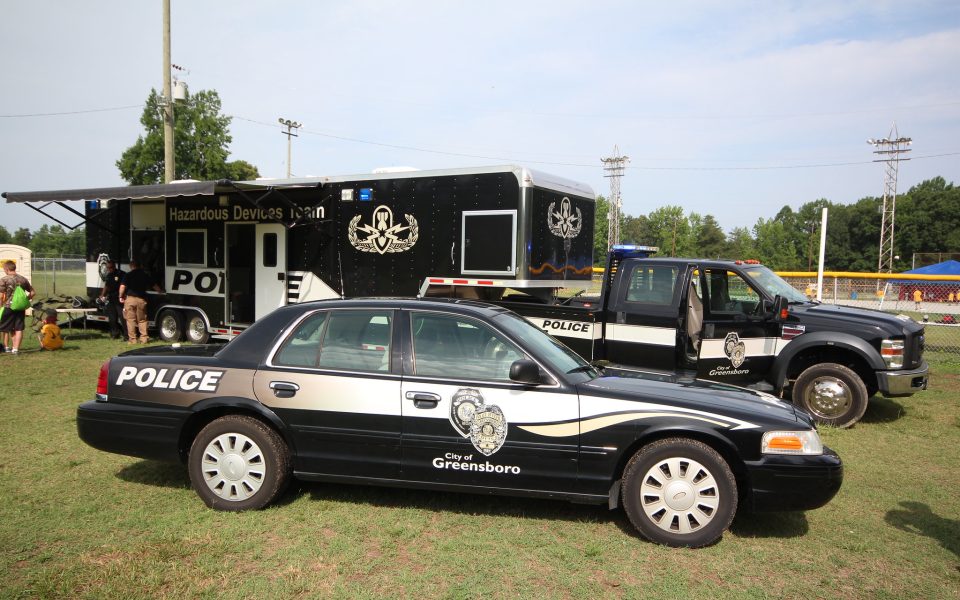Featured photo: The Greensboro Hazardous Devices Team (bomb squad) was at Sumner Civitan Park in Greensboro in June 2015. (photo taken by Trailers of the East Coast from Flickr)
Do more cops mean less violent crime?
That’s the idea posited by Greensboro police Chief Brian James and Greensboro City Council. During city council meetings in late March and early April, James discussed the police department’s new strategic plan, which outlines goals for the next three years. One of its main goals is to reduce violent crime in the city.
According to data collected by the Greensboro Police Department, there has been a steady increase in the number of homicides since 2018, when there were 40 recorded homicides. There were 45 in 2019, and 60 in 2020. There have been 12 homicides to date this year, compared to eight for the same period last year. Overall, crime is down by 8 percent.

“The homicides, obviously we have more now than we did a year ago,” James said during a city council work session on March 23.
City officials have promoted the idea that hiking officers’ pay and increasing staffing will curb the violence.
“Unfortunately, right now, as far as staffing, we’re in about the worst shape that we’ve been in several years,” James said during the work session.
The department is currently authorized to have 683 officers but only has 611 positions filled by fully trained officers, along with about 30 who are still in training, James said. He wants to hire more officers.
During the April 6 city council meeting, council unanimously voted to approve the next steps needed to add 16 additional officers to raise the department’s staffing level to 699. Several council members expressed outright support for increasing staffing, including at-large member Marikay Abuzuaiter, a longtime supporter of the police, and District 3 representative Justin Outling, who is running for mayor.
“It has to be approved by the council for it to constitute action that could help the chief and hopefully reduce the likelihood of violent crime in our community,” said Outling, who pushed for council to vote on action during the work session.
Mayor Nancy Vaughan responded: “We all have agreed that we needed more officers…. We have all made it pretty clear that public safety is a top priority.”
Sharon Hightower of District 1 said that she’s concerned about the homicides but says that the city should keep other employees in mind too.
“I’m concerned that we’ve had homicides for the last five or six years but when it happened across town, now everything must stop and we must address it immediately,” she said. “I just want us to be fair and equitable in what we do for all our employees.”
How will the officers be used?
The plan describes wanting officers in or around “hot spots,” or areas where crime tends to happen the most, including public housing communities. The plan also calls for creating a new crime analyst position and a monthly goal of 25 percent “available time” for all officers, in which they would be doing self-initiated work and vehicle stops to curb violent crime. One of the most notable parts of the new plan is the strategy to reduce violent crime by increasing traffic enforcement throughout the city. During the March 23 work session, Chief James explained this rationale.
“Often times, this is the strategy we’ve used for a number of years,” James said. “For instance, if we’re having a lot of break-ins in a particular area, we may actually do traffic assignments in those areas. When we do those assignments, we will detect someone as a suspect in the break ins or sometimes they just go away…. Often times it’s because of the visibility in the area that can deter a particular crime, so we try to model our traffic enforcement around crime issues as well as traffic issues.”
Later in the work session, James explained that in general, traffic enforcement is decided through statistical crash data, speed and traffic data and community complaints. However, historical data shows that traffic stops in Greensboro have disproportionately affected people of color. A 2015 New York Times article found that in Greensboro, “officers pulled over African-American drivers for traffic violations at a rate far out of proportion with their share of the local driving population. They used their discretion to search Black drivers or their cars more than twice as often as white motorists, even though they found drugs and weapons significantly more often when the driver is white.”
More recent data published by the Criminal Justice Analysis Center found that in the state of North Carolina, the disparities continued to exist in who was being stopped in 2019. Over the last decade, the number of traffic stops had fallen for all races, but the rate of stops for Black drivers only decreased 15 percent between 2009 and 2019, while the rate of stops for white drivers fell by 28 percent and other races decreased 30 percent during the same period. In 2019, the rate of stops for Black drivers was more than twice that of white drivers and almost 1.5 times that of other races, the report found. The data also found that Black drivers were stopped more for vehicle equipment violations rather than speed violations.
A recent report by Triad City Beat noted that these types of traffic stops disproportionately affect drivers of color and lower income individuals because of the number of fines and fees associated with the infractions. Kami Chavis, a law professor and director of the criminal justice program at Wake Forest University, said she is skeptical about the premise that increased policing curbs violent crime.

“We’ve learned a lot over the years about policing these low-level offenses and the detriment that that can have on the community and the trust that can erode when you have people who feel they are harassed unfairly,” Chavis said. “And we know Greensboro doesn’t have a great track record of that.”
The issue of racial disparities in traffic enforcement was vividly highlighted in the public consciousness with the death of Daunte Wright, who was killed by an officer during a traffic stop on Sunday in Minnesota.
“These stops can turn dangerous,” Chavis said. “If you’re going to have that kind of strategy, you better make sure those officers are trained and that they don’t have implicit biases, and I just question that as a strategy.”
To reduce the use of force by officers and raise racial awareness, part of the department’s strategic plan calls for increasing training for all officers. The plan mentions ICAT, or “integrating communications, assessment, and tactics” training which would focus on deescalating situations with individuals having mental episodes and more CIT, or crisis-intervention training as well. For the racial-equity portion, James said that he wants to take all new recruits through the International Civil Rights Center for tours and send more officers to the Racial Equity Institute.
However, a study cited by NPR that looked at the New York Police Department found that while officers expressed more awareness of implicit bias, their behavior when it came to arrests and interactions with the public remained largely unchanged.
More cops, less crime?
Chavis said she also wonders about the correlation between an increase in police officers with curbing violent crime. Studies that attempt to decipher the correlation between the two are varied and often contradictory. A 2007 report stated that the Clinton-era policy of adding a total of 100,000 police officers to departments across the country “had little to no effect on crime” and that crime was already decreasing when the COPS policy was put in place by Bill Clinton. Still, another study by Stephen Mello of Princeton University from 2018 found that municipalities with that hired more officers saw a decrease in crime rates. But even Mello added more context to his research on Twitter, where he stated that “reducing police may increase crime but may also reduce other undesirable outcomes such as police violence” and that “police manpower is not the only police lever for crime reduction, and funding could be diverted to other policies with significant effects on public safety.”
One model in Baltimore suggests that less prosecutions for low-level offenses could lead to less violent crime. In March 2020, Baltimore’s State Attorney Marilyn Mosby halted prosecutions for drug possession, prostitution, minor traffic violations and other low-level offenses to keep from incarcerating more people in the midst of a pandemic. One year later, Mosby announced that she would make the pandemic experiment permanent as the city saw drastic reductions in violent crime, as well as property crime. Homicide rates also declined. The rationale behind Mosby’s decision is reflected in research conducted in Suffolk County, Ma. The study, which analyzed more than 67,000 misdemeanor cases from 2004 to 2018, found that people who were arrested but not prosecuted for low-level, nonviolent misdemeanors were 58 percent less likely to commit another crime in the following two years.
Where critics say they want the money to go instead
Many activists who have been pushing for police reform and defunding law enforcement since the killing of George Floyd last summer say that money should be invested back into the community, rather than in police departments.
Casey Thomas, an activist with Guilford For All, advocates for infusing more money into social programs that will address the root causes of violence.
“I would encourage the city to really look at the Cure Violence program,” said Thomas. “You do need to target your response. It can’t just be that we change these policies broadly over the next 15 or 20 years, but the genius with that program is that it targets it directly.”
Founded in 2000 by Gary Slutkin, the Cure Violence program made its way to Greensboro in 2019 after the city contracted with One Step Further, a nonprofit run by Mayor Pro Tem Yvonne Johnson, to administer the program. According to the program’s website, Cure Violence attempts to prevent shootings by deploying workers to de-escalate tension in the aftermath of a shooting and to mediate conflicts. They also work to identity high-risk individuals and change their behaviors. And while the program is new and can only cover a few areas in the city, during a July 2020 press conference, James stated that that none of the homicides that had taken place in the city up until July had been in locations covered by Cure Violence.

Chavis said she understands that fixing systemic problems like poverty that lead to violence take time and that hiring more police officers seems like a quick fix. But she and Thomas both say that programs like Cure Violence could be an alternative to expanded law enforcement.
In November 2020, Greensboro City Council approved a new contract with One Step Further to continue Cure Violence in the city, but Thomas said that the program is still underfunded. She said she wants to see a shift from funding the police to the city making efforts to get at the root causes of crime.
“I think the strategic plan shows the gaps of some of these conversations,” Thomas said. “Until we create and can really understand violence that’s happening in the community and really expand that outside of people who are organizers or activists, until we can build more community support for this, you will have city council take that political bet that backing the police will do more.”
Join the First Amendment Society, a membership that goes directly to funding TCB‘s newsroom.
We believe that reporting can save the world.
The TCB First Amendment Society recognizes the vital role of a free, unfettered press with a bundling of local experiences designed to build community, and unique engagements with our newsroom that will help you understand, and shape, local journalism’s critical role in uplifting the people in our cities.
All revenue goes directly into the newsroom as reporters’ salaries and freelance commissions.


Leave a Reply